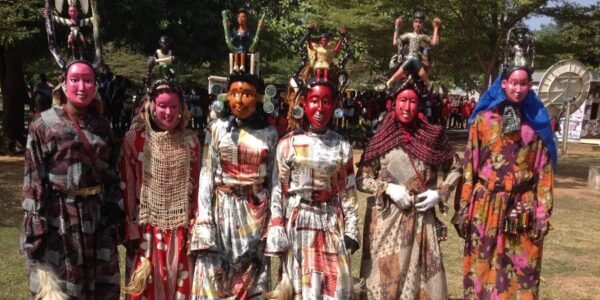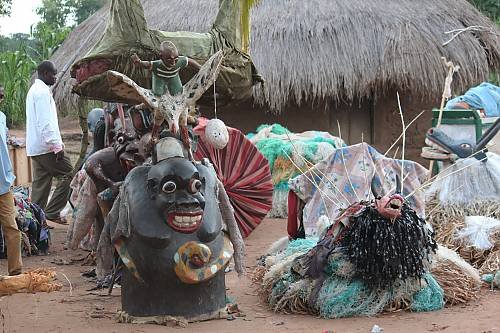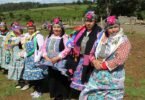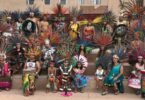
Tiv by ethnic group are a lively people mainly inhabiting the Benue State of Nigeria with amiable cultural values. Festivals are part and parcel of their culture and are a mirror of their culture’s fertility, history, and teamwork. While these are social and joyous occasions, they represent much more to the Tiv people and their relationship with the land, their forebears, and their existence.
This article examines Tiv festivals prevalent in Tiv land to understand the cultural, spiritual, and social aspects of the Tiv people.
1. Kwagh-Hir Festival: The Theatrical Celebration of Tiv Culture

The Kwagh-Hir festival occupies a unique place in the Tiv people’s cultural endowment/heritage. This festival is all about a play-acting drama musical dance and masquerade with the use of puppets. Kwagh-Hir, through which the Tiv people retell their history, entertain, and teach them good moral lessons.
Key Features:
- They include works of art, typical people’s practices, myths, most of the tales they present, and other matters of social concern or historical account on stage.
- Puppets and masquerades are used in the performances as spirits, ancestors, and/or mythical characters.
- Drumming and traditional songs are used to offer the presentations, so that environment is entertaining and engaging.
Cultural Significance:
- Kwagh-Hir serves to tighten the belt within the communal structures, and everybody in the community is involved.
- It plays the role of an archive of Tiv oral practices and acts as a tool for transmitting these to the next generation.
- Overall, the festival celebrates the Tiv culture in terms of art and narrative and strength in being able to make commentaries on present-day matters.
2. Ibiamegh Festival: Honoring Ancestors and the Land
Tabitom, the Ibiamegh festival, is a feast for the ancestral spirits and the spirit of the land. This is a once-a-year cultural and religious event performed in honour of the family’s dead ancestors’ spirits in the hope of a fruitful year ahead.
Rituals and Practices:
- Both liquor and food in honour of dead people are provided to the spirits at the ancestral shrine or at a tree.
- The traditional priests conduct prayers that will benefit the community and also protect it.
- Tabern hopes dances and songs call upon the ancestors to come for a dance as well as honour their achievements.
Cultural Significance:
- The festival helps the Tiv people to draw closer to their ancestors, which plays a big role in enhancing spirituality for the living because the life and death circle is fully embraced by the current generation.
- It depicts the Tiv people leading an agriculture-based life and how they depend on God and other natural resources for food.
- Ibiamegh reunites families and clans because it unites relatives in celebration of their roots.
3. Akombo Festival: Celebrating the Tiv Cosmology
The Akombo festival is therefore derived from the Tiv’s basic supernatural repute and the attempts aimed at deifying the forces of nature. Akombo has meaning as charms or sacred objects and governs health, fertility, and protection, among other aspects of life. This festival is performed through dances and other activities to control or celebrate such powers in the community.
Key Elements:
- Animals or foods, most of which are domestic or farm products, are offered to the gods or spirits depicted by Akombo signs.
- A convincing emphasis is on the part of traditional healers who can explain the spirits’ will and attempt to bring their balance.
- To ensure they get favour and do away with adversity, community members engage in dances, chants, and prayers.
Cultural Significance:
- It means that the festival helps the Tiv people to remain linked to their cosmological contacts, thereby giving them control over their existence.
- It simply reminds them that they rely on natural and supernatural forces for survival and to thrive.
- Tiv people, through communal rituals, maintain social relations and thus social responsibility for the group’s welfare.
4. Makan U Tiv: The Harvest Festival
Tiv people are largely an agrarian community and hence attach so much value to farming. Makan U Tiv is a festival of harvest, which is held every time farmers are through with their farming activities and ready to harvest. It’s a time to celebrate the harvest of hard work and thank the gods and ancestors for a good harvest.
Festivities:
- The festival initiates with the concept of harvesting, where the people of the community combine themselves to gather food from a variety of crops.
- A champagne banquet also makes the occasion complete, and traditional meals cooked from the newly harvested produce, including yam, maize, and millet, are prepared.
- Joyous events include dances, music, and storytelling.
Cultural Significance:
- Makan U Tiv underscores the Tiv people’s connection to the land and their gratitude for its abundance.
- It promotes unity and collaboration within the community, as people work and celebrate together.
- The festival offers an opportunity to teach younger generations about farming practices and the value of hard work.
5. Tiv New Yam Festival: A Celebration of Renewal
The New Yam Festival, celebrated in many Nigerian cultures, holds a special place in Tiv land. Known locally as Ihyarev U Yam, this festival marks the start of the yam harvest season, symbolizing renewal, gratitude, and abundance.
Key Traditions:
- The festival begins with the ritual roasting and eating of new yams, an act performed by elders to bless the harvest.
- Traditional dances and songs celebrate the importance of yam as a staple food and a symbol of prosperity.
- Families exchange gifts of yam to strengthen social ties and express goodwill.
Cultural Significance:
- The festival highlights the centrality of yam in Tiv culture, both as a food source and a symbol of wealth.
- It fosters intergenerational teaching, as elders pass down rituals and farming techniques to younger members of the community.
- Ihyarev U Yam reinforces the Tiv people’s appreciation for the earth’s bounty and their collective efforts in cultivating it.
6. Dance Festivals: Showcasing Tiv Rhythms and Movements
Dance is an integral part of Tiv culture, and dance festivals provide an avenue for the community to showcase their dynamic rhythms and intricate movements. Tiv dances, such as Swange and Tiv Aondo, are characterized by fluid motions, rhythmic footwork, and dramatic expressions.
Dance Highlights:
- Swange: A traditional dance performed to melodious tunes and characterized by graceful, flowing movements. It is often performed at weddings, festivals, and other celebrations.
- Tiv Aondo: A more energetic and theatrical dance that often incorporates storytelling and symbolic gestures.
Cultural Significance:
- Dance festivals celebrate the Tiv people’s artistic talents and creativity.
- They provide a platform for cultural expression, bringing communities together to celebrate their shared identity.
- Through dance, the Tiv people convey emotions, tell stories, and preserve their traditions.
7. Significance of Festivals in Tiv Culture
Festivals in Tiv land are not just events but are integral to the social, spiritual, and cultural fabric of the community. Their significance can be understood in various ways:
a. Preservation of Heritage
Festivals serve as a repository of Tiv traditions, ensuring that customs, songs, dances, and rituals are passed down through generations.
b. Spiritual Connection
Through rituals and ceremonies, festivals reinforce the Tiv people’s connection to their ancestors and spiritual beliefs.
c. Social Cohesion
Festivals foster unity and collaboration, as they bring together families, clans, and communities to celebrate shared values and achievements.
d. Celebration of Nature
The Tiv people’s reliance on agriculture and the natural world is reflected in their festivals, which honour the earth’s bounty and the cycles of life.
Conclusion
Festivals hence in this Tiv’s land remain an active manifestation of culture, group entities as well as spirituality. Oftentimes, people only focus on the theatrical display of the Kwagh-Hir, the sacred dance of Ibiamegh or the agricultural Thanksgiving ceremony Makan U Tiv; they all remind us of the values of the Tiv culture. In addition to lively demonstrations of colour and craft, Tiv festivals provide historical evidence of a people’s strength and solidarity rooted in their cultural and geographical context.






